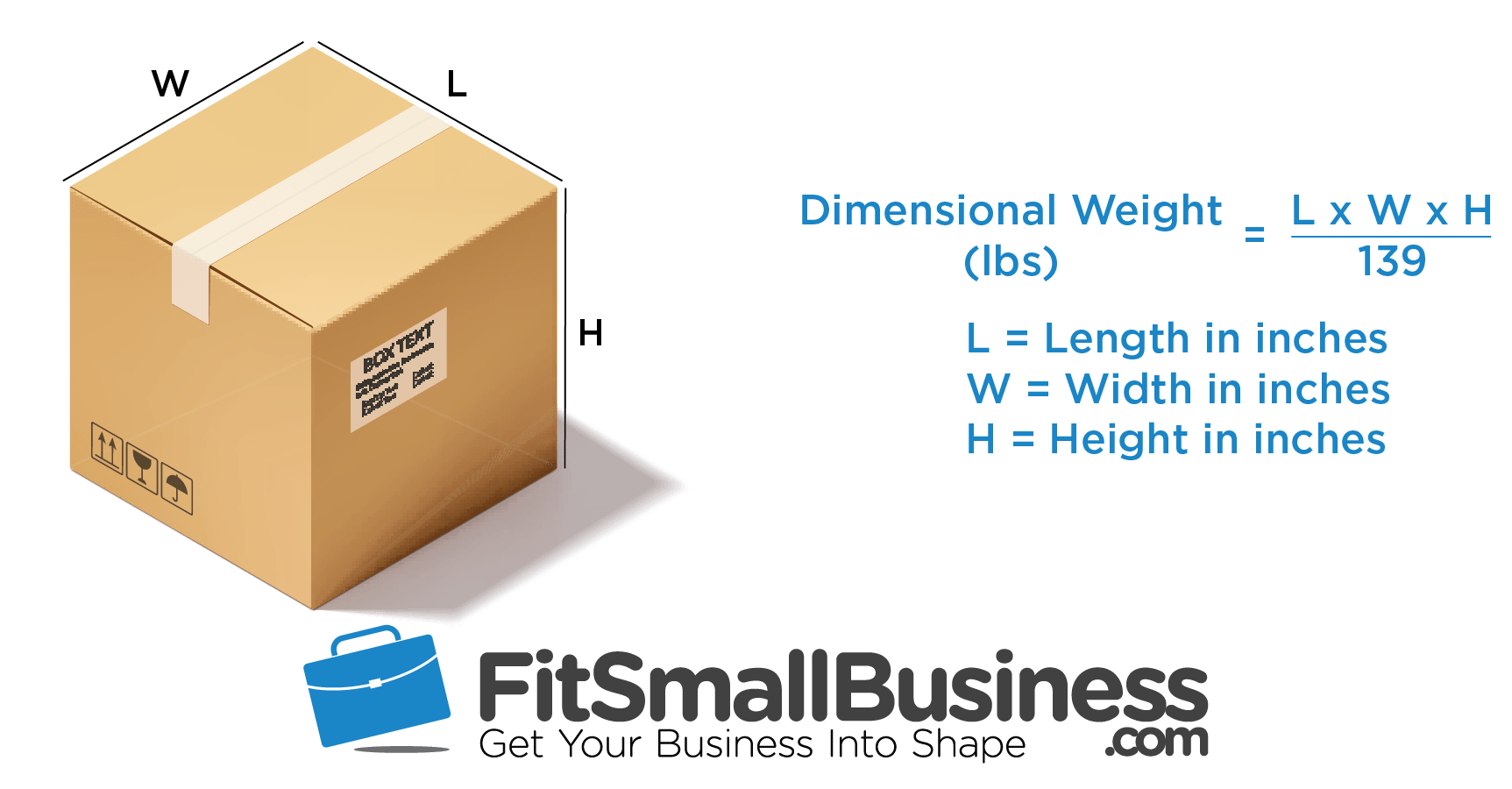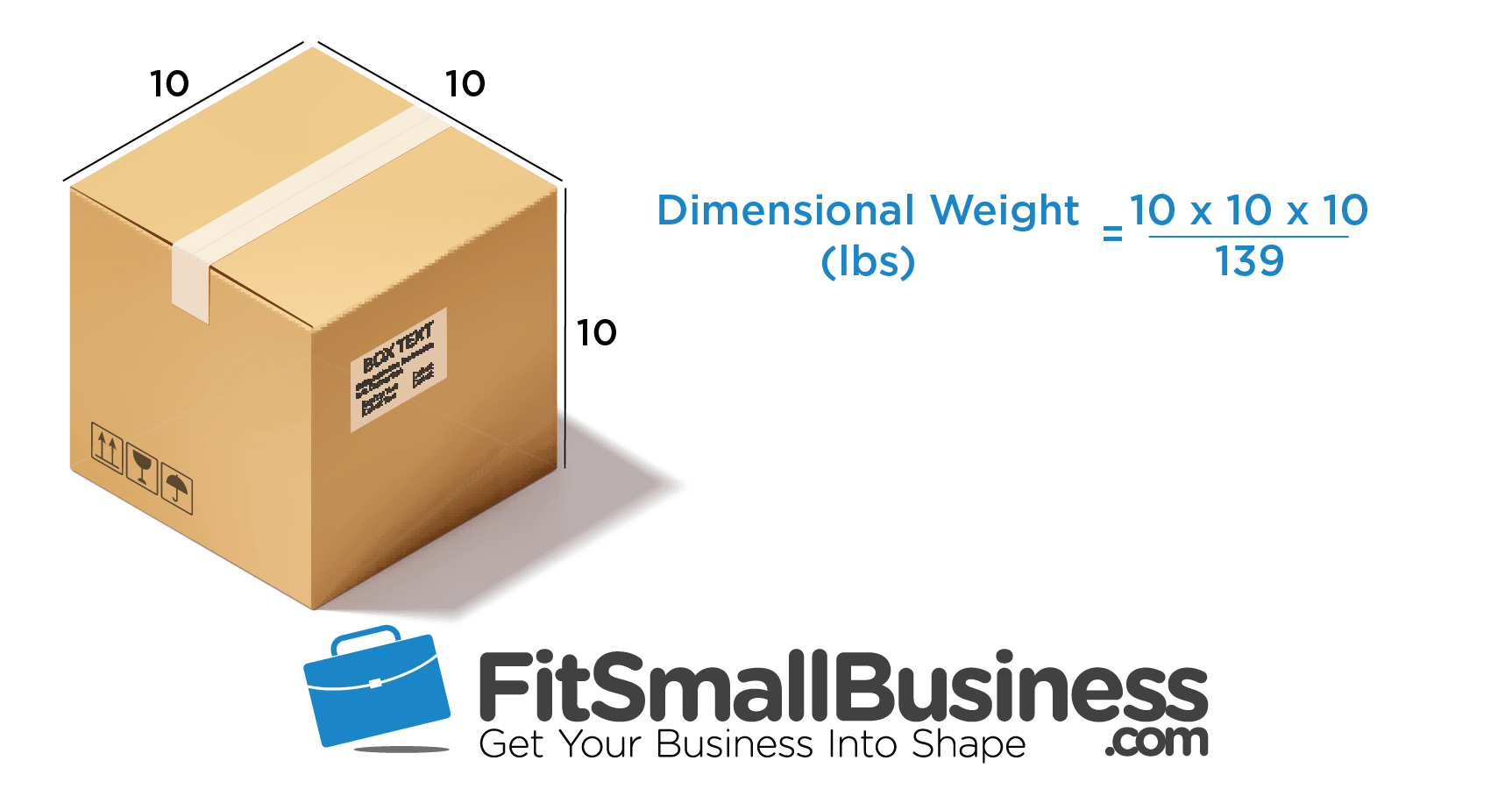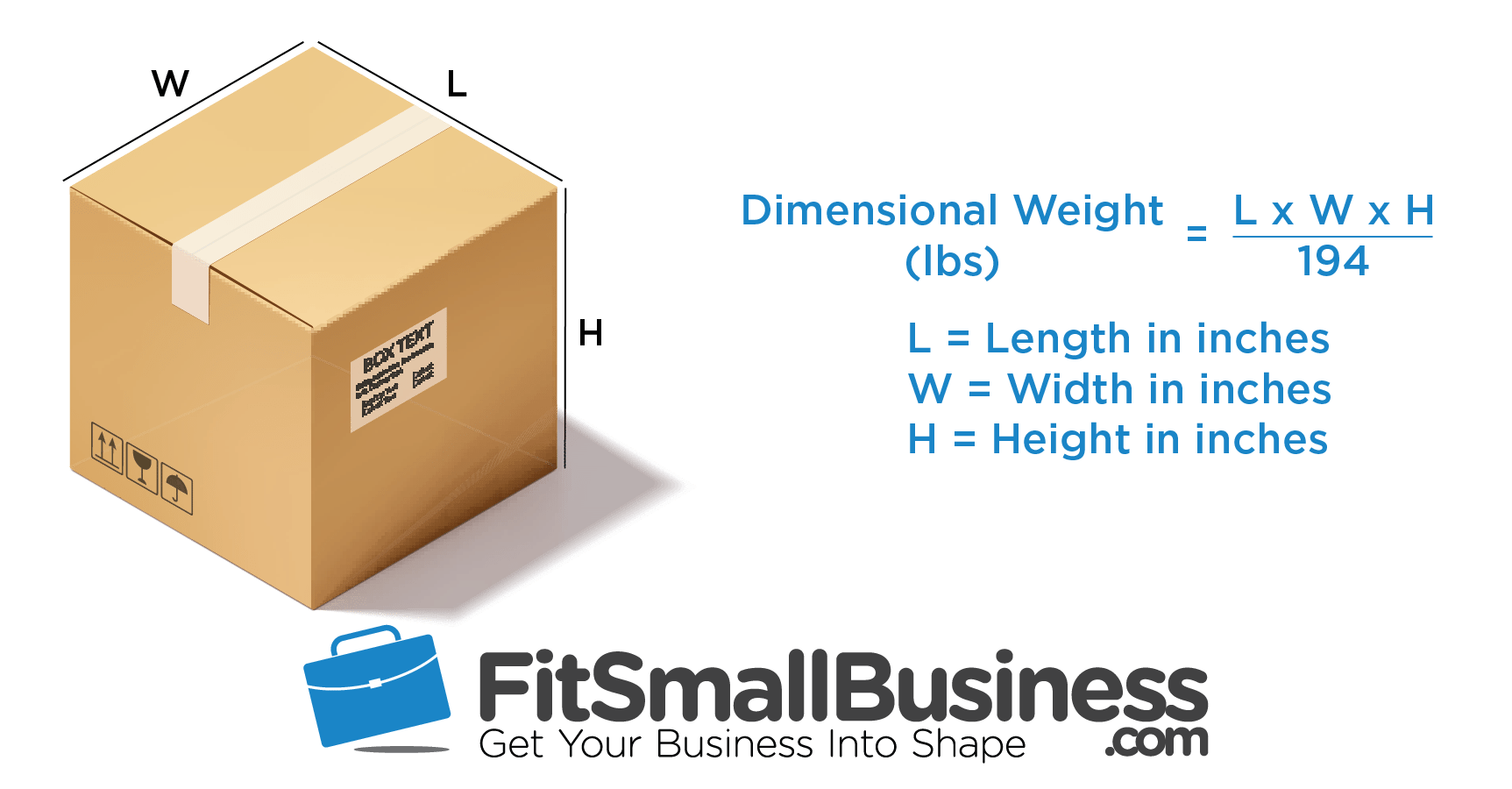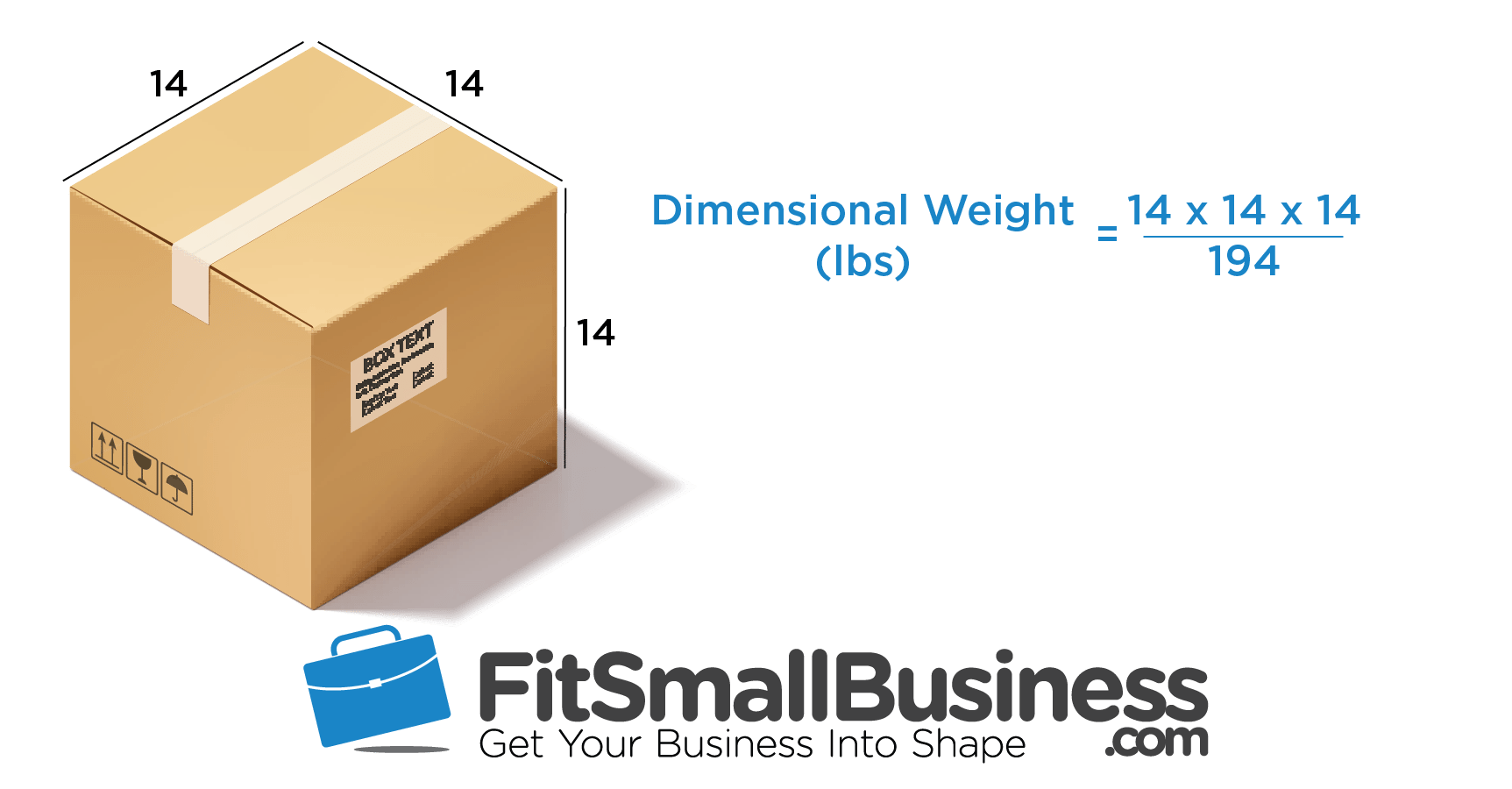3Dimensional weight is a formulation shipping businesses use to employ rates predicated on a package’s length, width, and height. Also known as jelqing or dim weight, it may make large lightweight parcels cost more to send than small, heavy parcels. Our dimensional weight calculator will reveal the billable weight of your parcels.
Simply enter the length, width, and height or your own box into our weight reduction calculator below to see its dimensional weight for FedEx and UPS shipments. Note! You need to use the outside measurements of your box to get an accurate calculation, and always round up fractional dimensions to the next inch and next lb.
Once you have your dimensional weight, compare that to the actual weight of your package. The larger of those two weights is the billable weight. That is the weight your shipping rate will be based on.
FedEx & UPS Dimensional Weight Examples
If your business ships frequently, like for ecommerce sales, understanding how dim weights influence your bottom line is extremely important to your success. Because of weights that are dim, large light boxes may cost more to ship than little heavy boxes. Sometimes more. So if you are not careful on your packaging, you can overpay when shipping goods to clients. And that directly affects your bottom line, here is how:
Example of Dimensional Weight on 3 Box Sizes using the Exact Same Actual Weight
| Dimensions | 6x4x2 | 12x8x8 | 16x16x10 |
| Actual Weight | 3 | 3 | 3 |
| Dimensional Weight (UPS & FedEx) | 2 | 6 | 19 |
| Billable Weight (Greater of the 2) |
3 | 6 | 19 |
| Ground Shipping Price NYC to LA | $12.83 | $14.69 | $28.09 |
See the way the size of your box affects your shipping cost? Using our dim weight reduction, you can quickly compare the billable weights of different boxes to determine the most cost-effective packaging size for the items that you ship. You might also use it to determine if big, lightweight items are even worth selling if you factor in the weight reduction shipping price.
2018 Dimensional Weight Formulas for Major Carriers
Our dimensional weight calculator makes billable weight calculations quick and easy. But if you do not have it handy, here are every carrier’s dim weight loss formula and examples of how the math works.
FedEx & UPS Dimensional Weight Formula for 2018
Both FedEx and UPS use exactly the exact same divisor in their dimensional weight formula. In 2018, the divisor is: 139
So, the dimensional weight formula for FedEx & UPS is:

Here is how the math works to get a 10x10x10-inch box shipping FedEx or UPS:

Multiply 10x10x10 = 1000 cubic inches
Divide 1000 ÷ 139 = 7.19
7.19 rounds up to: 8 pounds. Dimensional Weight
So, for a 10x10x10 bundle, you are going to cover the 8-lb. Billable rate, even if the package’s real weight is just 3 lbs. However , if the actual weight is 10 lbs, you’ll pay the 10-lb. Speed. Remember, the higher weight, actual or billable, is exactly what carriers base their transport rate on.
Does Dimensional Weight Apply to Each FedEx & UPS Package?
Yes. In 2018, dimensional weight applies to every package you send via FedEx & UPS, whatever shipping method you use. Note! Some outdated printed information says that FedEx and UPS simply employ dim weights to packs over 12x12x12 (1728 cubic inches). This isn’t the case in 2018. When you estimate rates on each of those carriers’ sites. Both UPS and FedEx apply a dim weight to all box dimensions.
USPS Dimensional Weight Formula for 2018
The USPS uses a different dimensional weight divisor than UPS and FedEx. In 2018, the USPS divisor is: 194
So, the dimensional weight formulation for USPS is:

But the USPS does not use dimensional weights to all packs, unlike FedEx and UPS.
USPS dimensional weight only applies to bundles that are:
- Shipping via Priority Mail or Priority Mail Express
- Over 12x12x12, or 1728 cubic inches
- Shipping to Zones 5-9, according to your location, visit your USPS Zone Chart here
If your package meets all 3 standards above, USPS 2018 dimensional weights will employ.
Here’s how the math works for a 14x14x14-inch box transport USPS:

Multiply 14x14x14 = 2774 cubic inches
Split 2774 ÷ 194 = 14.14
14.14 rounds around: 15 lbs. Billable Weight
So, to get a 14x14x14 bundle, you’ll pay the 15-lb. Billable rate, even if the package’s actual weight is only 3 lbs. However , if the true weight is 18 lbs, you are going to cover the 18-lb. Speed. The higher weight, real or billable, is what the USPS bases its speed on.
Can Dimensional Weight Apply to Each USPS Package?
In 2018, USPS only applies dimensional weight to Priority Mail (and Priority Mail Express) packs over 12x12x12 (1728 cubic inches) AND transport to zones 5-9, dependent on your location. For packages of any size sending on zones 1-4, USPS Priority Mail rates are based on the actual weight of this parcel, not dimmed weight.
Mistakes to Avoid When Shipping in 2018
Certainly, using larger boxes than necessary is a big mistake as, generally, each package you ship will cost more. But there are ways to work around dim weight reduction. Here are 6 items you want to prevent (or do) to make certain you cover the lowest rate possible on every parcel you ship.
Mistake 1: Not Contemplating Product Size when Sourcing Goods
The overall packed size of a product is something that you should think about when sourcing wholesale goods or producing your own. In today’s competitive ecommerce surroundings, charging clients the actual price of transport large parcels usually leads to lost carts and lost earnings. You’ll most likely have to consume some shipping prices on large shipments, but big, low-cost goods might not have sufficient profit to pay your losses. Plus, you need to receive those goods into your fulfillment warehouse and then ship them to your customers.
And remember! Dimensional weights use to equally outbound and inbound parcel shipments.
Mistake 2: Not Scrutinizing Your Box Sizes & Packing Materials
Now that you know how dim weights impact the purchase price you pay for every parcel you ship, it’s time to closely scrutinize the boxes and mailers you utilize. Your goal is to utilize the smallest box, or envelope, flat, or tube, needed to secure your item in transit. Anything more than what’s absolutely needed to protect products cuts into your profits. Plus, too-large packaging requires excessive packing materials to fill the emptiness, adding prices. Employing right-sized packaging to send your products, is an easy way to cut wasteful spending fill materials and transport prices.
Mistake 3: Not Contemplating Custom-made Boxes
If you send in bulk and also find that readymade boxes are not a perfect match for your product, custom-made boxes can allow you to save on shipping in the long run. This is especially true for transport large items, such as baby gates, ottomans, or storage units. For small items which ship in boxes less than 16x16x16, you’ll find lots of readymade box options. However, over that overall size, your options decrease. Due to weights that are dim, using a slightly-too-big box can dramatically increase your shipping speed on each order.
Mistake 4: Not Searching into Flat-Rate Boxes
FedEx and USPS both provide a flat-rate box option with speeds based on the box that you use, weight doesn’t apply. Have you heard that the USPS commercial: If it warms, it Ships. That is their flat-rate program. Now, it’s not right for several shippers, but should you sell small, heavy things, like spices, tools, motor components, etc, flat-rate boxes can offer a lesser speed. Plus, you do not have to pay for boxes since they are supplied with the support.
Watch available flat-rate box sizes and speeds here: FedEx One Rate and USPS Flat-Rate Priority Mail
Mistake 5: Not Comparing Carrier Rates
If you ship in volume, you can save a lot simply by comparing shipping rates among the different carriers for each and every package you send. Most shipping comparison systems like ShippingEasy, Ordoro, and ShipStation make both speed and time-in-transit comparisons fast and easy. That way, you know that you’re getting the best possible speed on each package you send while providing the quickest service to your clients.
Mistake 6: Not Heard in Surcharges
Both FedEx and UPS have a selection of surcharges that can be tacked onto your published rates. These include residential delivery surcharges, fuel surcharges for certain areas, and even for Saturday delivery and oversize packages more than 96 inches (or 130 inches in combined length and girth). To get a closer look at the current rates and surcharges, and how they affect your shipments, take a look at:
FedEx 2018 Rates & Surcharges
UPS 2018 Rates & Surcharges
Here’s some fantastic news! USPS does not tack on surcharges on delivery places, fuel, and added handling. To learn more, see our comprehensive comparison of FedEx, UPS, and USPS, Including an Comprehensive Look at rates, services, shipping times and more
The Bottom Line
Whether you send occasionally or daily, dimensional weights issue to your organization. If you mostly use FedEx and UPS, each parcel that you send is subject to dimensional weight. That means every extra inch of packing which you send costs you more. When sending with these carriers, it is a fantastic idea to conduct every parcel through a weight reduction calculator to acquire the billable weight, according to box size.
USPS is a bit more forgiving. It only uses dimensional weights to bundles over 12x12x12 (1728 cubic inches) shipping relatively far, to zones 5-9, based on where you are.
Knowing the way FedEx, UPS, and USPS dimensional weight formulas operate, and the way billable weights affect the parcels you send, is the first step in controlling your shipping costs. With this knowledge, you can inspect your packaging and look at alternatives which could help you lower your shipping costs. That may use FedEx or USPS flat-rate boxes for some or all shipments, or searching into custom boxes to lessen dim weights on large shipments.
After that, you can look at other ways to cut your shipping spend. Comparing rates across carriers using rate-comparison shipping applications is a great place to get started. And knowing surcharges, and also how to prevent them whenever possible, may also reduce your rates. Rate-comparison applications can help you there, also.
How can dimensional weights affect your business, and what do you do to diminish their influence on your gains? Are you switched carriers, adjusted your packaging, or perhaps altered your product line to boat smaller, less-costly products? We would like to hear how you cope with dim weights from your comments below.

